I was constantly on the lookout for quicksand when I was a kid. I blame this on Scooby Doo and the wide array of environments he & Shaggy encountered the stuff— abandoned amusement parks, haunted ghost towns, an alley in the city, the desert. By Scooby Doo logic, where wouldn’t you run into a treacherous pool of quicksand? And what 80’s kid doesn’t have the image from A Never Ending Story of Atrayu’s horse sinking tragically into the muck and fog seared into their memory? I stayed alert.
I played outside a lot in our huge yard climbing the pear trees and making forts beneath the sunny yellow forsythia bushes lining the driveway. I spent summer afternoons slashing through the juicy bamboo shoots growing wild in the furthest reaches of the property. I went looking—turning rocks over, poking at nests, sneaking through backyards and sloshing through streams four blocks deep in the neighborhood. My mom or dad would stand on the cement stoop in the side yard and holler my name as loud as they could at dinnertime.
This draw to nature only increased as I got older and while my fear of quicksand eventually subsided, other real and possible dangers took its place. In my twenties I worked for AmeriCorps NCCC and was sent to a different state every two months for a new project— many of them outdoors. I did trail work in Big Bend National Park in Texas, wielded a chainsaw for fire mitigation in the mountains of Colorado, herded a flock of sheep to eradicate invasive weed species on hillsides in Montana, and built big game fencing on an elk refuge in Wyoming. I learned all about bears, elk, moose and mountain lions and how to handle an encounter with each of them. Luckily, none of those skills were ever needed.
Most recently, I farmed in Texas for 9 years and shared the land with rattlesnakes, scorpions, biting red ants and black widow spiders. In 2019 I was bit by a rattlesnake. I still stay alert!
Which is why, prior to flying to Thailand— a varied habitat of tropical forests, steep mountains, lakes, rivers and oceans which I intend to explore—I do some light research about potentially dangerous wildlife and how to handle them.
There are upwards of sixteen species of venomous snakes in the country. Various hooded cobras, diamond-headed vipers and others with names like Calloselasma Rhodostoma and Bungarus Fasciatus which sound more like Harry Potter spells than poisonous reptiles.
There are pythons which aren’t venomous per-se, but will strangle you and then eat you whole. I learn that just last month one emerged from the water on a famous tourist beach in Phuket, a top destination on my travel itinerary. (No one was harmed.)
I read a couple articles on how to fend off a python just in case, but it all seems moot when I read this: people die of a python attack because their blood pressure rises so high that the heart cannot beat. Translation: a python scares you to death, then it eats you.
In terms of mammals, several websites advise caution around Macaque monkeys and wild elephants. Visiting “ethical” elephant sanctuaries is a thing here, but the first week I’m in Thailand the BBC reports of a female tourist killed by an elephant she was bathing at a wildlife sanctuary…. I find mention of a recoup in the tiger population but they must live so deep in the forests as there is no fanfare about encounters.
My first stint in nature is at a small farm I found on Airbnb located about 40 minutes Northeast of the old city in Chiang Mai. For $31 a night I have my own private tiny house nestled into some banana trees with a view of the mountains. There is a quaint porch, a small kitchen, a nice sized bathroom and a sitting area outside with a stone soaking tub. It also includes breakfast and all the reviews rave about the host being a fantastic cook.
The drive from Chiang May out to the farm in the mountains is lovely. We pass a few smaller villages with modest roadside restaurants and spirit houses draped in flower garlands. Banana and teak groves pop up on either side of the road and stray dogs sleep precariously near the swoosh of passing cars.
Further out still, rice paddies come into view. I’d read it was the off season for rice so I am delighted when I see only half the paddies lay fallow while the others are displaying vibrant green shoots. It is the green of spring— electric, vibrant, juicy. Tiny little plants full of promise.
The farm itself sits on a hill overlooking a seemingly never-ending mountain range. I get out of the taxi and am greeted by my hosts, the hot afternoon sun, and a chorus of birds. Apple and her husband Toshe help with my bag and walk me to the tiny house to get settled. I tell her I am interested in hiking and ask “Do I need to look out for snakes or anything?”
My tiny house on the hill!
Her response is not at all what I am expecting. Her eyes are wide, factual, unblinking, “Dogs” she tells me. Huh? “There are many wild dog. Use stick,” she says to me and points at a set of thick, bamboo walking sticks leaning against the porch.
Wild Dogs?! Zoinks!
I am so shocked at this revelation and my brain is conjuring up disturbing images of my throat being torn out that I can’t even articulate follow up questions. Google did not prepare me for this! I spend the rest of the afternoon reading on the safety of my porch and listening to the birdcalls.
The next morning on my way to breakfast I hear what I believe to be gun shots— a loud crack of thunder rocks the valley followed by a scuffle of wings taking flight. Apple confirms my hunch, tells me there are bird hunters nearby. Various bird species are hunted every day near here for personal supply and selling at market.
I’m suddenly feeling like I should have packed a fluorescent orange vest.
I ask again about the dogs. “So….I use the sticks to swing at the dogs..?” I feel like my voice sounds high-pitched and ridiculous but if she says yes, I’m not leaving the property. “No, you stand firm,” she tells me and mimics stamping walking sticks into the ground beside each leg. There is also a bicycle for my use parked in front of my tiny house. “And if I’m on the bike….will they chase me and….bite me?” I’m already making a mental note to google rabies in Thailand. “No biting. Just barking” she says. She does not seem concerned and maybe I am being overly cautious since I enjoy all my limbs so much. I can’t help but feel that my risk tolerance is much lower than these happy, friendly people who ride mopeds on highways with their young children sans helmets or seat belts or even a knee pad!
I’m quickly realizing that this vision I had of myself frolicking through the nearby mountains was pure fantasy…..
The good news is Apple is delighted to show me around the farm. They moved to the quaint, 3 acre property just a couple years ago after she’d worked at a bank in Bangkok for thirty years, then as a massage shop owner in Chiang Mai for five. Along with her husband Toshe who is from Japan, having a farm to care for with an airbnb and the opportunity to cook for people is their dream retirement. They are both proud and modest about all they have accomplished in a short time.
The main crop on the farm is a small yellow chrysanthemum grown for tea. The blooms are hand-picked, then placed in a dehydrator which looks like a mini greenhouse on stilts in the backyard. The blooms are dry in 3 days and the tea is sold to merchants in the city and served to their airbnb guests— its delicious!
There is a small vegetable garden currently sown with cool season lettuces and kale, an area for herbs like Thai basil, mint, and lemon grass, and loads of fruit trees. Several groves of bananas dot the property and I spy both the funky maroon banana flower and the green fruits developing on several trees. The longon berry trees are bare of both bloom and fruit this time of year, but I’ve seen the small, white orbs floating in vats of longon juice in the city. It is intensely sweet and much of it is exported to China.
Dusk on the farm
There are several lemon bushes with both flowers and giant pale yellow fruits, and rows of spiky pineapple plants with just a hint of the fruit emerging from its center. There are several varieties of mangoes, a mulberry tree, a couple coffee bushes and a row of plumeria with the last of the seasons sturdy, aromatic flowers.
I offer to help out on my second day. Since the rain stopped many of the banana leaves have shriveled down to a papery, brown husk. They hang like a dull hula skirt around the tree trunks. Apple shows me how to tug at the base of the leaf, then use the shears to cut off the dead growth. I find this type of grooming incredibly satisfying. You can look back on your work and see how removing the dead leaves has opened up space around the plants and shows off the remaining healthy leaves which are electric green and lush. I spend a few hours tidying the trees. I see a banana spider, some gnarly red ants that would surely leave a welt if they got a hold of me, some snails hunkered down in the damp folds of the rotting leaves, and one particularly scary looking red and blue centipede whose legs quickly glide it back into the darkness from whence it came.
Grooming the banana trees
I don’t have a car out here. While I did get an International license prior to arriving, the chaotic traffic and the fact that they drive on the lefthand side of the road here has squashed my confidence. Did I mention all the kids without helmets on the highways?? Luckily Apple and Toshe are incredibly generous with their time. They take me to the local temple one day where I marvel at the hand-painted ceilings and walls, and on another day they drive me to the top of the highest mountain in the region where we pass pick-your-own strawberry fields. On each outing Apple and her husband field my questions about what is growing nearby.
Apple & Toshe at Doi Saket temple
In fact, we spend the whole week talking about plants and farming and starting a new business. We swap stories about attempting to grow new things, our failures and successes, the pests and diseases giving us the most grief. As it turns out, farming is a challenge anywhere on the globe. It is a language—a set of feelings— that translates seamlessly.
Most universal? The joy of the harvest! Apple harvests a basket of huge lemons one morning and as she’s walking to the house with the heavy weight of the fruit she is smiling so widely, “Harvest make me so happy!” she exclaims and I know the feeling exactly. In the days to come she is at my door with exquisite lemon cake, and a fresh lemon soda. This kind of alchemy— field to plate— is truly one of my favorites.
Above: Apple & her lemon harvest. Below: Her lemon cake!
We talk too about all the differences in our cultures. I confess to Apple I was a bit startled by some of the foods I saw in Chinatown like the piles of chicken feet. She laughs and laughs and exclaims, “But chicken feet sooooo good! Simmer in soup pot!” I believe her, 100%…..but I’m not ready to try it!
When my week on the farm comes to a close, the walking sticks have not left their post by my front steps and the bike hasn’t moved an inch. I’m leaning into the fact that I’m formulating my own set of rules to live by in this foreign place. Figuring out what feels safe or healthy or fun. Some risks just feel unnecessary.
I thought I was coming here to hike. What I got instead was so much more than a walk in the woods! XOXO.
A few more pics of Apple’s food because I was SO spoiled all week. Every dinner was several courses— usually a soup, a main dish, a side dish and always fresh fruit (and flowers!). Everything was presented so beautifully— check out the little pot of savory egg custard with the carrot flower matching the flower on the lid! Days I helped on the farm she would bring me a treat— like the lychee rose and strawberry cheesecake below served with a homemade lemon soda. All of it was incredible, and much of the ingredients are grown on the farm!

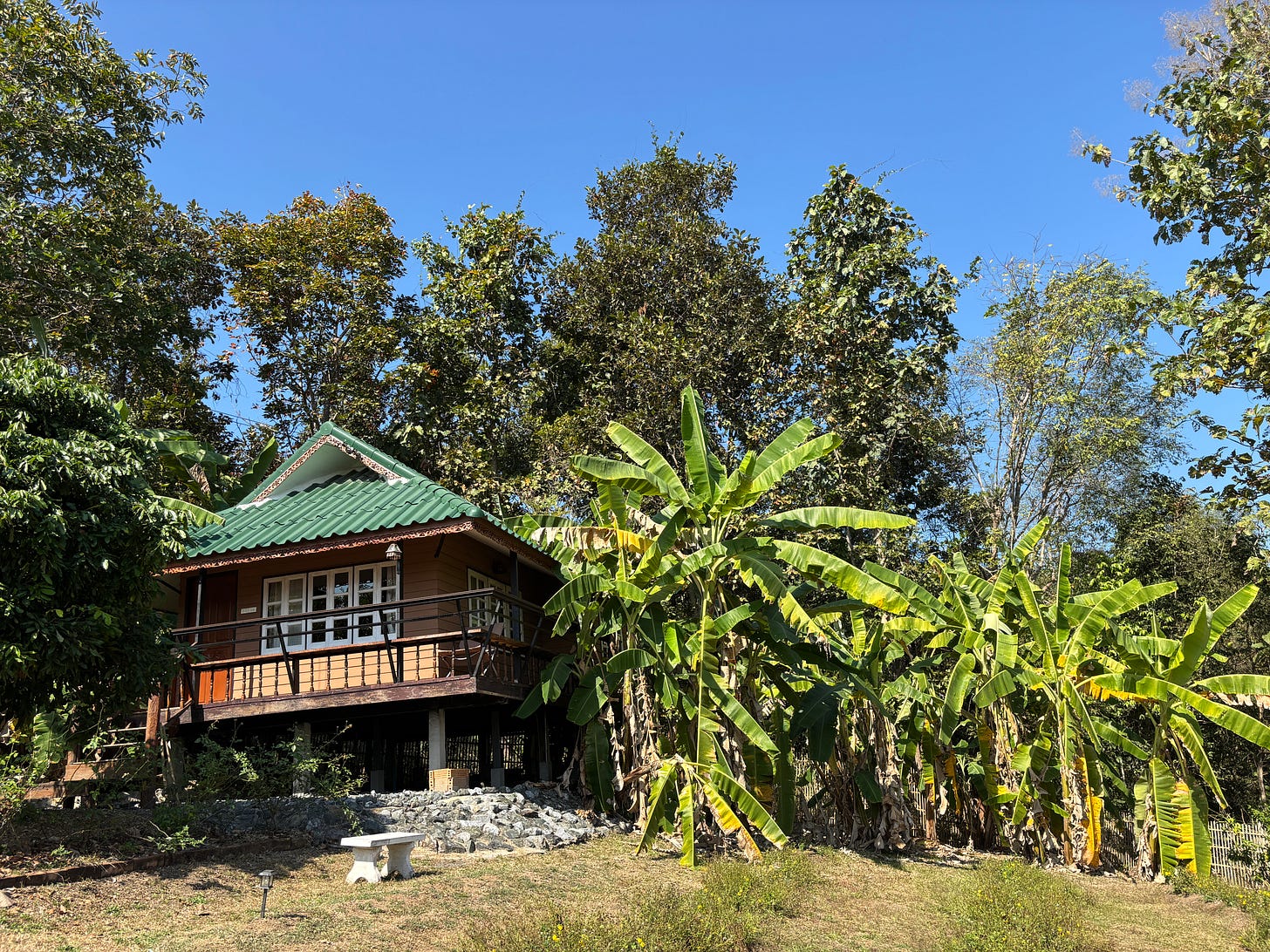
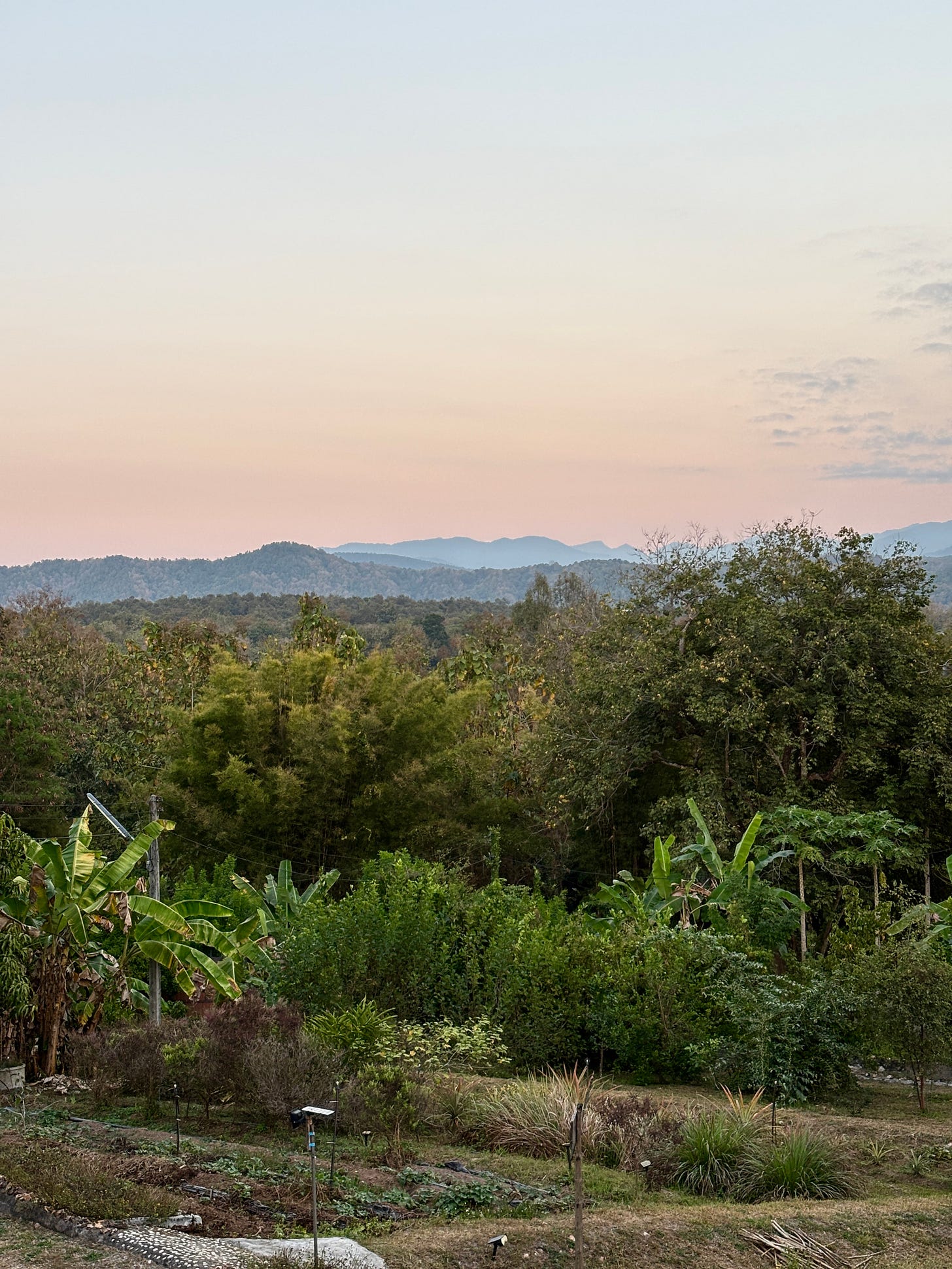
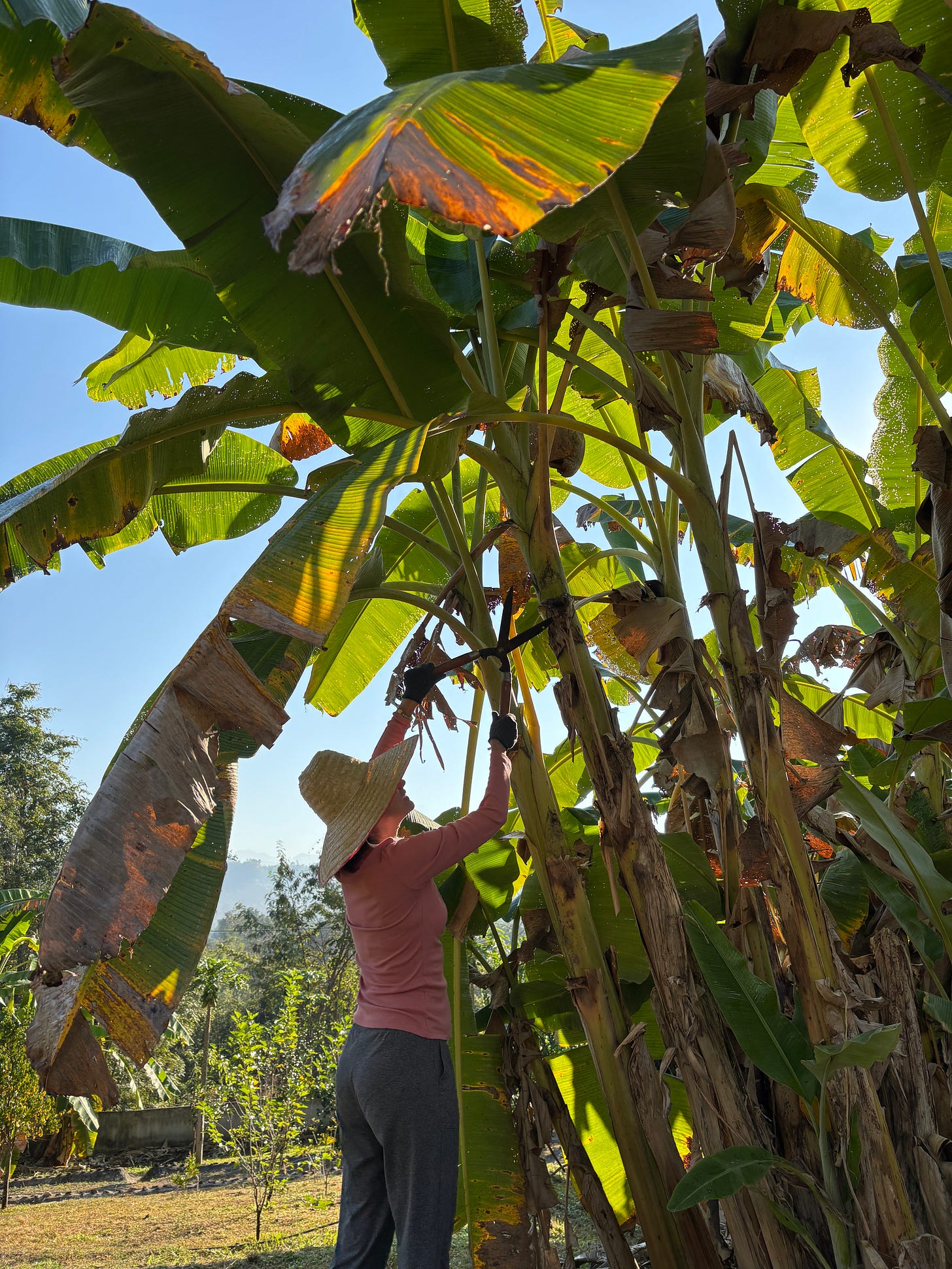

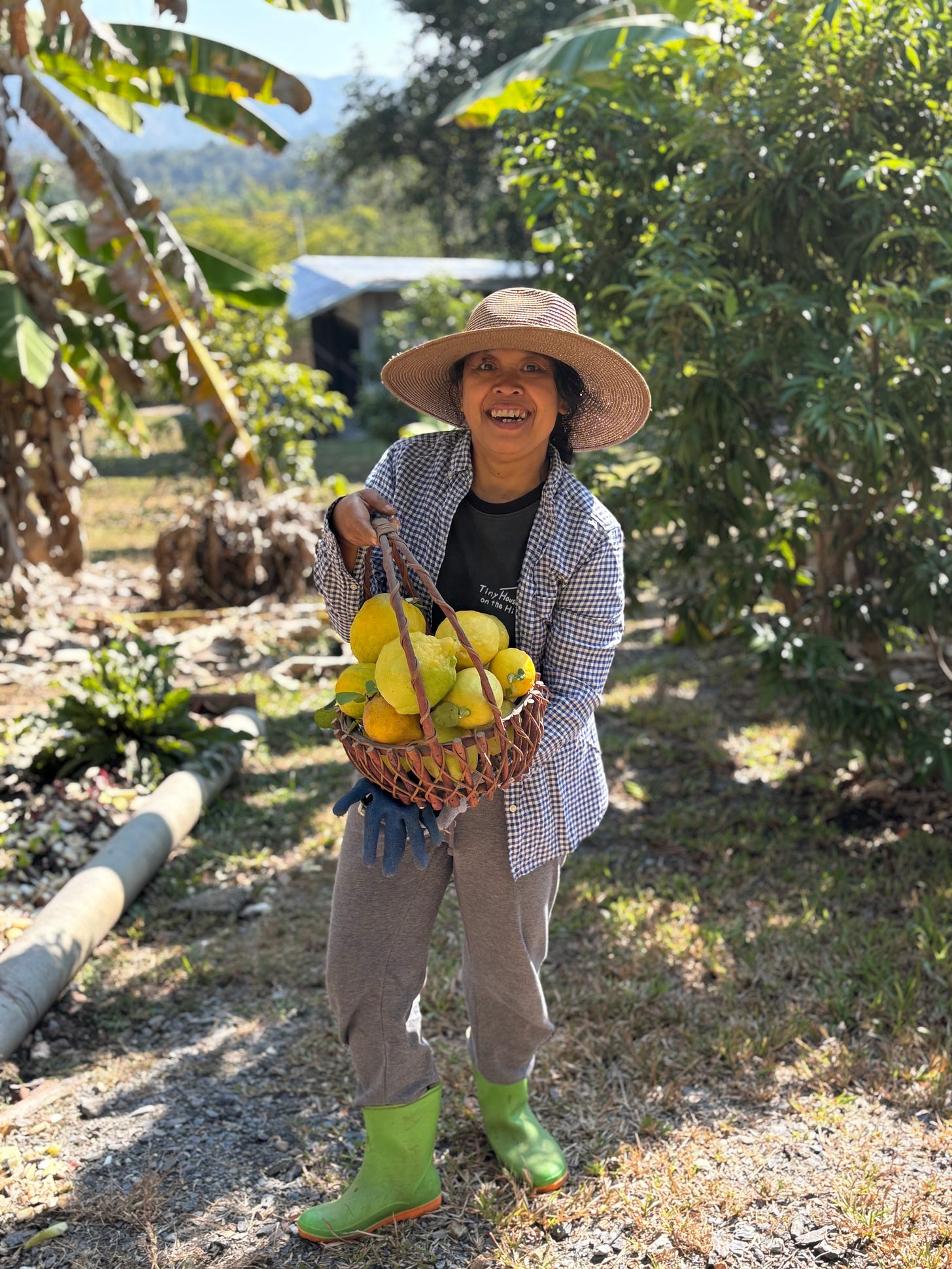
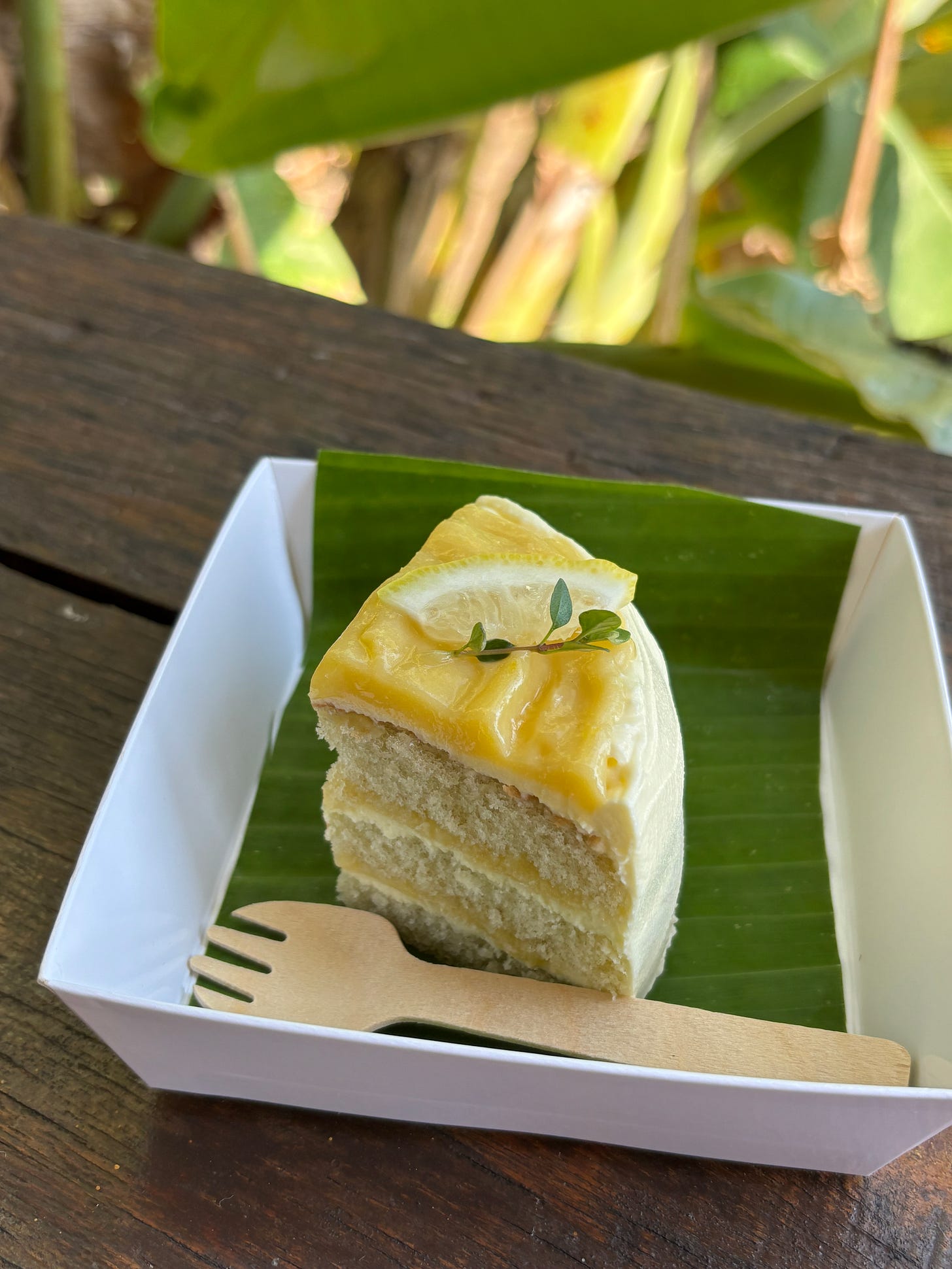
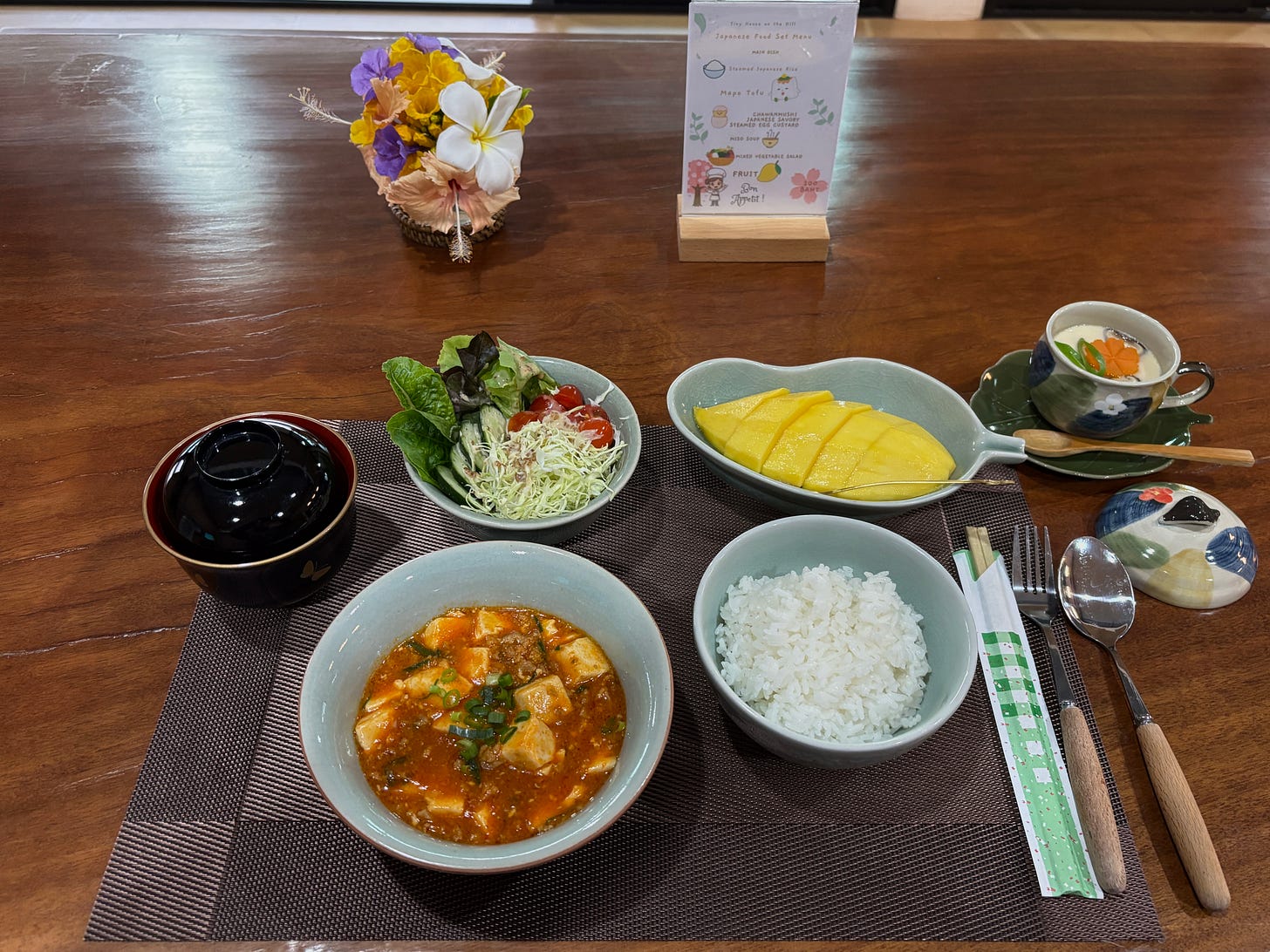
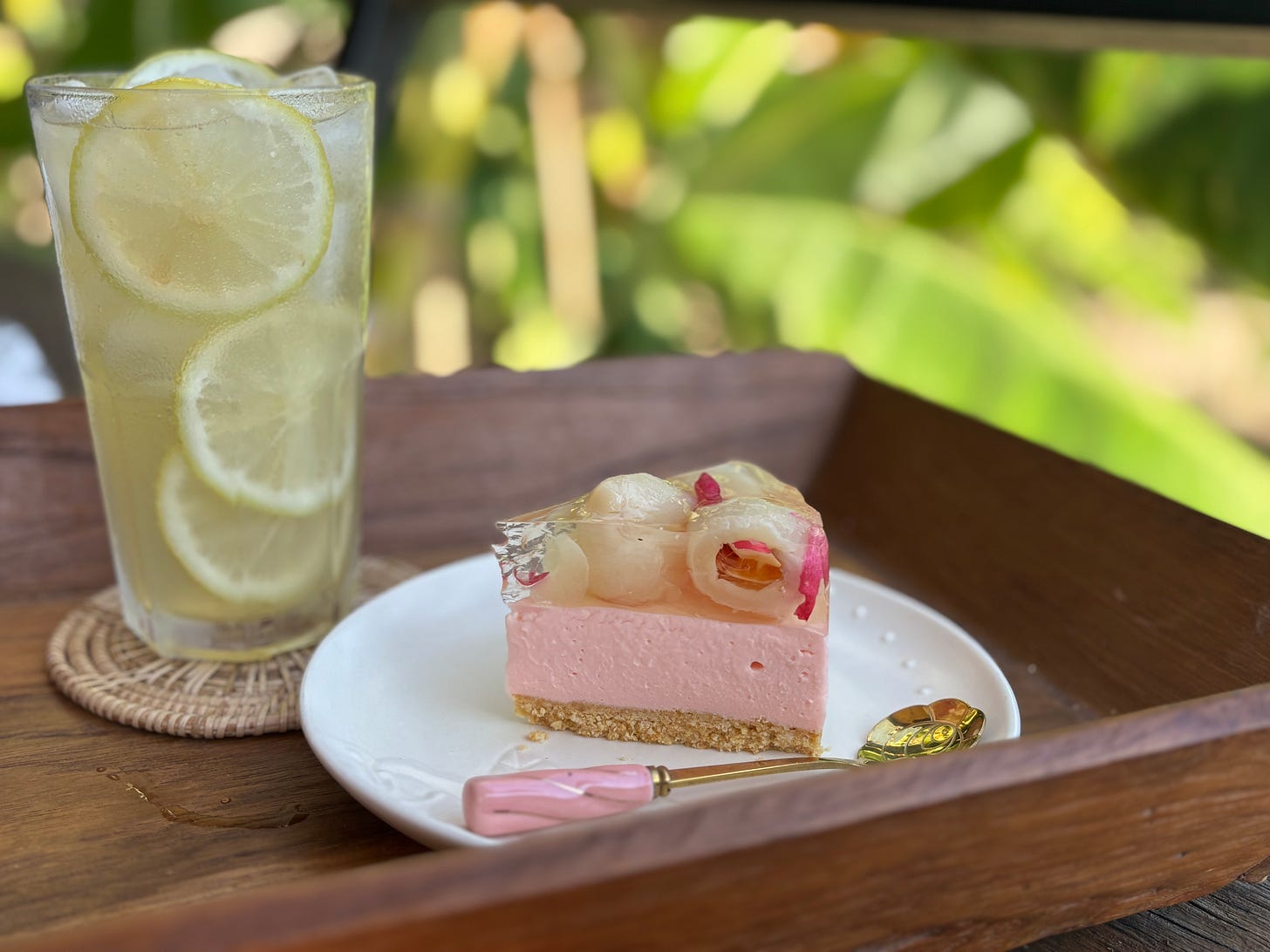
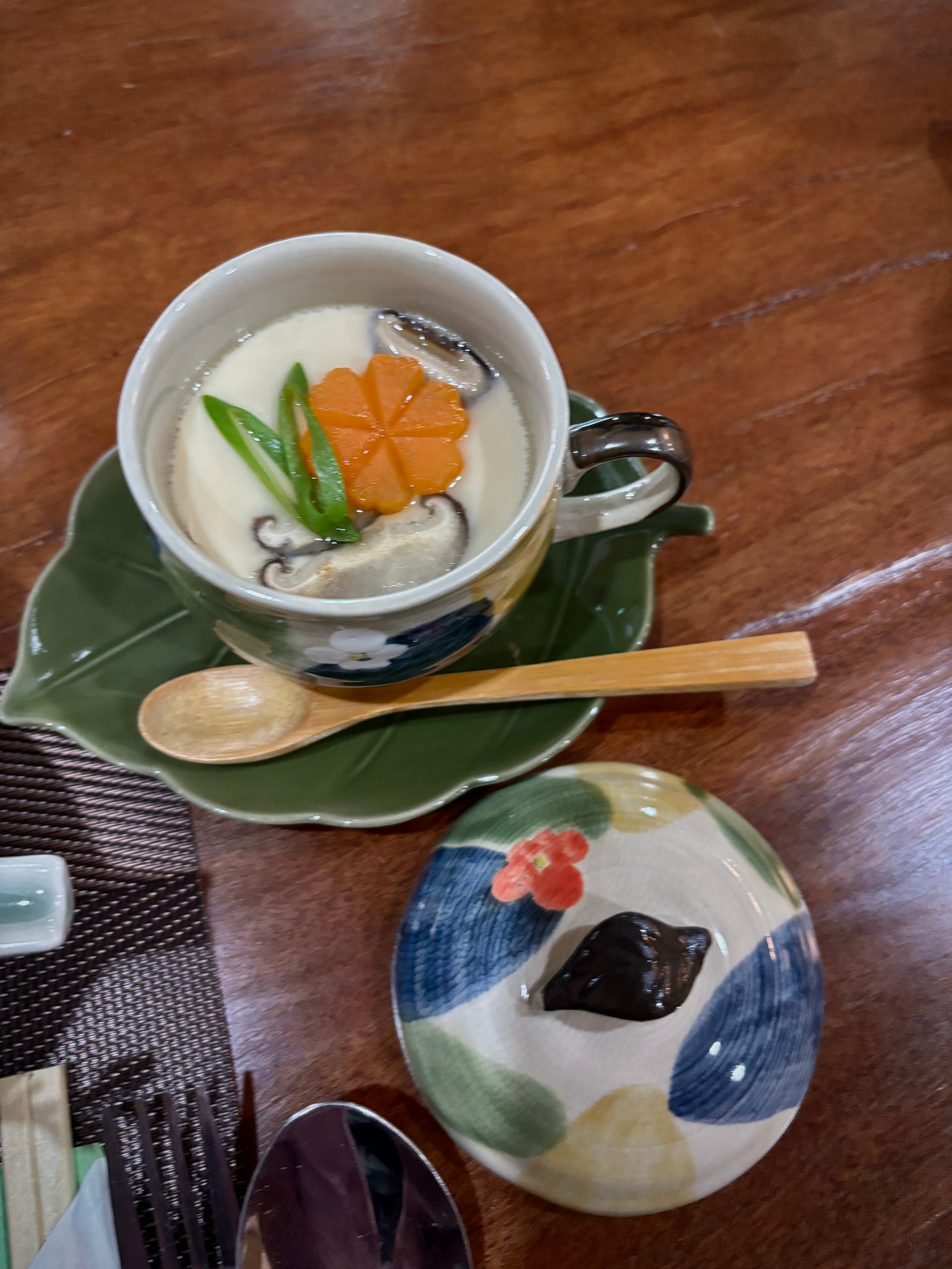
You’re writing is beautiful. I was laughing out loud at some many spots. I’m so proud of you for doing this solo trip!! And grateful you’re allowing us to follow along. The food pics are amazing ❤️❤️❤️❤️